An In-Depth Exploration of Read-Only Memory and Its Various Types
Read-Only Memory (ROM) plays a requisite role in the foundational architecture of modern digital devices. Serving as the bedrock for storing basic firmware and system settings, ROM ensures that significant data remains consistently available, irrespective of the device's power state. This article digs into the diverse functions and forms of ROM, exploring its integral contribution to computing from basic operational stability to advanced programming techniques. It highlights the distinct types of ROM—such as Mask ROM, PROM, EPROM, and EEPROM—each tailored for specific reliability, flexibility, and programming needs. By examining the intricate processes of how ROM is programmed, the article further elucidates ROM's censorious role in various technological contexts, from everyday consumer electronics to sophisticated industrial systems. The exploration not only underscores ROM's attributes of non-volatility and data permanence but also addresses the technological challenges and innovations shaping its evolution in the digital era.Catalog

Figure 1: Read-Only Memory (ROM)
The Functions of Read-Only Memory (ROM)
Read-Only Memory (ROM) is a desperate part of digital devices. It stores firmware, the basic software that enables hardware to perform basic functions. Unlike volatile memory like RAM, which loses data when powered off, ROM keeps its contents indefinitely due to its non-volatile nature. This permanence is intentional, as ROM is programmed during manufacturing and embedded into the device's circuitry.
Programming ROM involves directly encoding software onto integrated circuits. This is different from mutable storage solutions like hard drives, where data can be rewritten freely. Changing ROM, if possible, requires specific, intricate methods that are time-consuming and need specialized hardware tools, making routine updates impractical.
ROM’s primary role is to store required system instructions, such as the Basic Input/Output System (BIOS). The BIOS manages initial hardware configurations and the boot sequence when a device powers on. ROM’s inflexible nature is beneficial here as it provides a secure, tamper-resistant environment for core programs that need stability and consistency, like the BIOS.
Due to these characteristics, ROM is ideal for storing software that governs constitutive, unchanging tasks within a device’s operation. However, its rigidity limits its use in applications requiring frequent updates, like adjusting to new security protocols or enhancing functionality. The risk of introducing bugs or vulnerabilities in a non-updateable environment is high. Thus, while ROM is requisite for device reliability and initial functionality, its use is limited to scenarios where change is neither required nor desirable.
Cataloging the Different Types of ROM
ROM technology is divided into several categories, each designed for different programming needs and levels of flexibility.
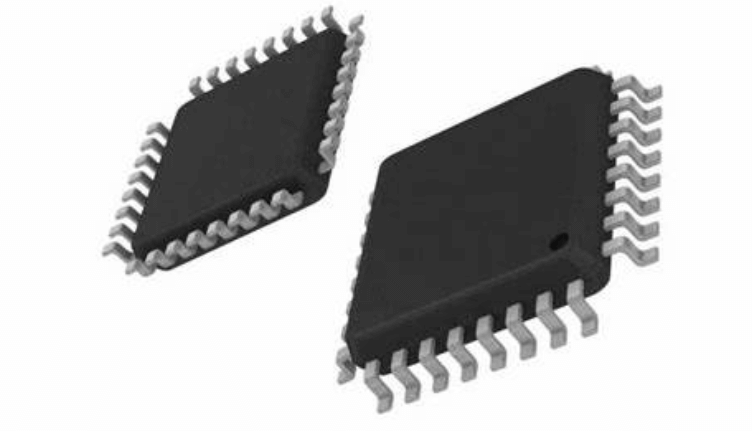
Figure 2: Mask-Programmed ROM
Mask-programmed ROM is the simplest type. It is created during manufacturing with fixed pathways for electrical currents. This design locks the ROM's functionality from the start, making any changes after manufacturing impossible. This type is used in applications where the software requirements are clear and unchanging over the product's lifetime.
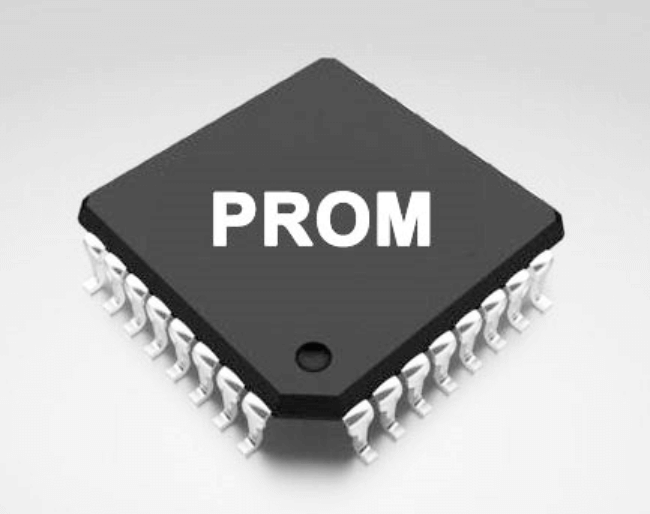
Figure 3: Programmable ROM (PROM)
Programmable ROM (PROM) allows for one-time customization. During programming, specific connections within the ROM are permanently disabled or "burned out" by applying high voltage to certain fuses in the chip. This provides flexibility at the initial programming stage but makes changes irreversible. PROM chips are also sensitive to static electricity, which can damage the internal circuitry if not handled carefully.
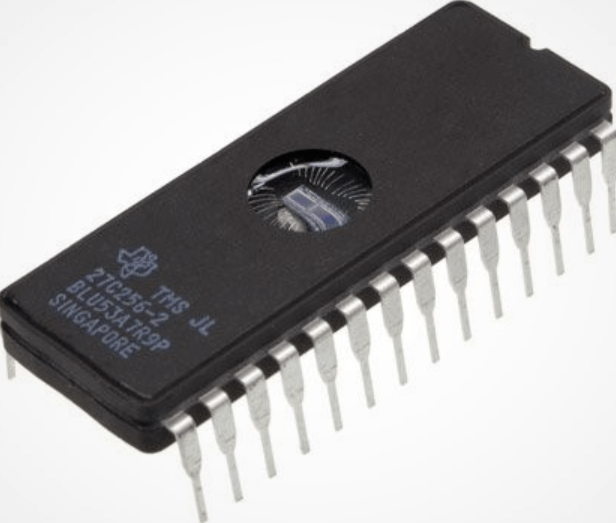
Figure 4: Erasable Programmable ROM (EPROM)
For applications needing dynamic updates, Erasable Programmable ROM (EPROM) offers more reprogramming capabilities. EPROM can be reset and reprogrammed by exposing the chip to strong ultraviolet light, which clears its stored data. However, this process requires removing the chip from its operational environment and placing it under a UV light source, limiting update speed and efficiency.
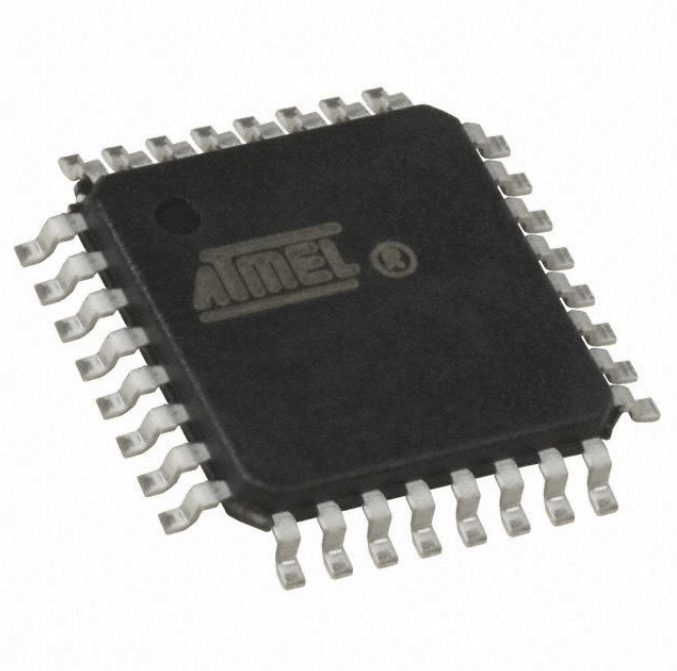
Figure 5: Electrically Erasable Programmable ROM (EEPROM)
EEPROM represents a significant advancement. It can be erased and reprogrammed without removal from the circuit, using electrical signals. This allows for frequent and precise updates, making it ideal for applications where software settings need periodic adjustment or where data must be stored and modified during normal operation. EEPROM's ease of use and flexibility make it suitable for storing user preferences, device configurations, and other modifiable parameters in consumer electronics and other dynamic environments.
How Programmable Read-Only Memory (PROM) Functions?
Programmable Read-Only Memory (PROM) is a flexible, permanent storage solution dynamic for various electronic applications. Unlike traditional ROM, which comes with pre-loaded data, PROM allows data to be added after manufacture using specialized programming devices.
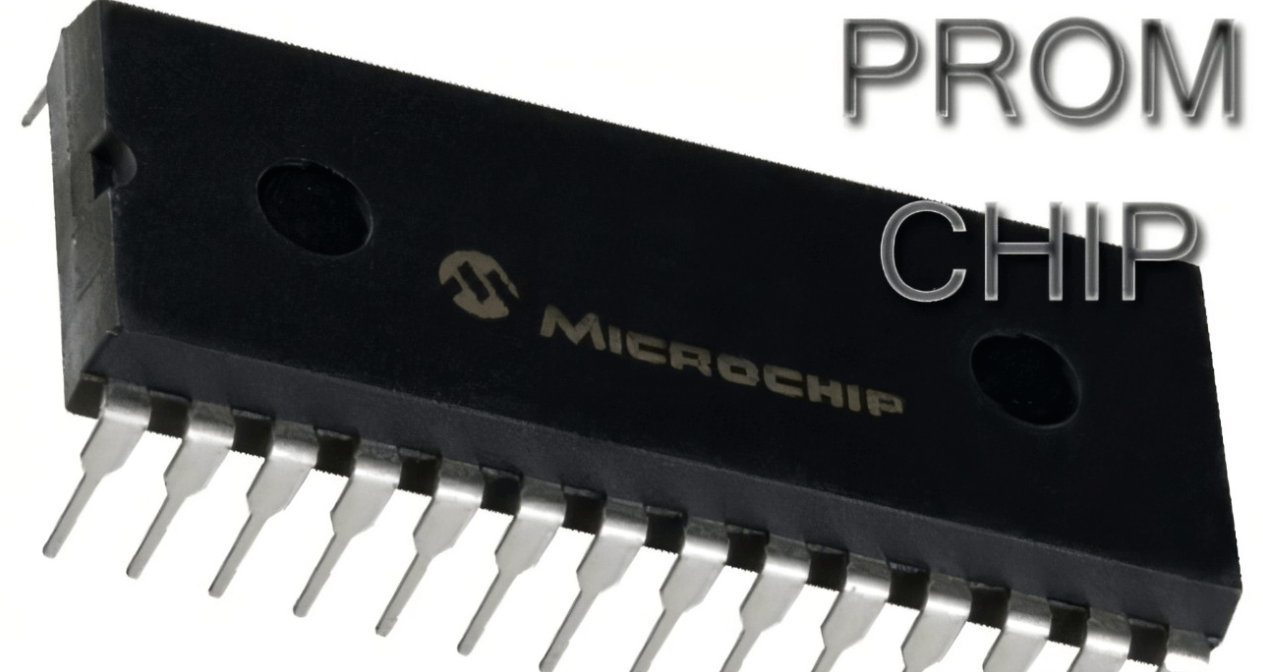
Figure 6: Prom Chip
A PROM chip contains a grid of cells, each with a fusible link. Initially, these links are intact, representing the binary '1' state. During programming, technicians apply specific electrical currents to chosen cells, "blowing" the links and changing their state to '0'. This process requires high precision to ensure accurate and permanent data encoding. Once a link is blown, it cannot be repaired, making the data stored on PROM permanent and secure.
PROM Pros and Cons
Blank PROM chips are cost-effective, especially during the prototype stage. They allow designers to make iterative data adjustments at a low cost compared to fixed ROMs. However, PROMs have vulnerabilities. They are susceptible to physical disturbances such as static electricity, which can blow fusible links unintentionally and corrupt data. This sensitivity necessitates careful handling and strict static control in environments where devices are exposed to variable static levels or frequent handling. While PROMs are not robust against physical disturbances, their precision and adaptability make them ideal for controlled settings.
How Erasable Programmable Read-Only Memory (EPROM) Operates?
Erasable Programmable Read-Only Memory (EPROM) is an advanced form of ROM technology that allows data to be written after manufacture and erased for reprogramming. This dual functionality is settling in electronic product development, where firmware updates are frequently needed to enhance product performance.
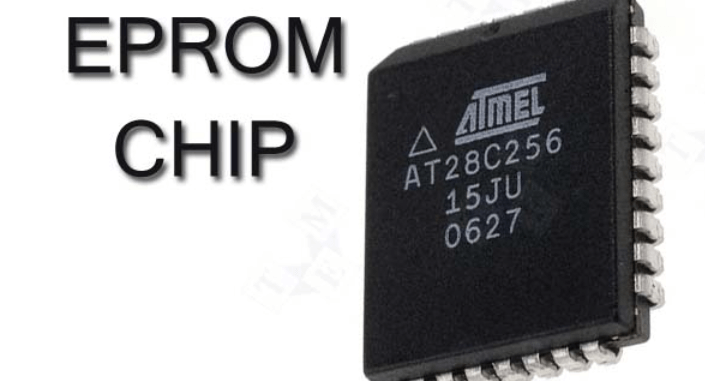
Figure 7: EPROM Chip
EPROM technology relies on floating-gate transistors to retain data. These transistors trap electrons, setting the binary state to charged (1) or discharged (0). Programming involves applying high-voltage pulses to the gates, causing electrons to accumulate and change the transistor’s state. This state is non-volatile, meaning it remains even without power, ensuring long-term data storage.
To erase data from an EPROM chip, it is exposed to ultraviolet (UV) light for about 15 to 30 minutes. The UV light frees the trapped electrons from the floating gates, erasing the data and resetting the cells to their default state. The chip is then ready for reprogramming using the high-voltage method. This cycle of erasing and reprogramming can be repeated many times, making EPROM versatile for prototyping and testing.
Handling EPROM requires precise control to prevent data corruption. Technicians use specialized equipment to deliver exact voltage levels during programming and a controlled UV light source for erasure. This ensures data integrity and accuracy throughout development. This detailed procedure highlights the sophistication of EPROM technology and its practical use in electronics design, emphasizing its capabilities and the meticulous approach needed for its operation.
Dynamic Role of ROM in Modern Computing
ROM is influential in computing, found in devices ranging from desktops to mobile gadgets. It stores useful code and settings that ensure devices function correctly. This includes the Basic Input/Output System (BIOS) and other vibrant system instructions for initial hardware diagnostics and booting operating systems. Because ROM is non-volatile, it retains unsafe data across power cycles, ensuring device operability and reliability after shutdowns or restarts.
Beyond traditional computers, ROM is key in many digital technologies. In gaming consoles, it holds game and system data. In smartphones, it manages basic firmware and recovery operations. In vehicles, digital speedometers use ROM for consistent performance measurements and accurate displays. In all these cases, ROM provides a stable, unchangeable foundation for ultimate operations and needed system instructions.
End-users have minimal direct interaction with ROM. However, technicians and engineers play an insistent role during the manufacturing and programming phases. They embed pre-defined software into ROM, determining how a device initializes and responds under various conditions. This precise setup ensures that every powered device behaves predictably and consistently according to its designed specifications, highlighting ROM’s broad and serious application across modern digital platforms.
Data Preservation Capabilities of ROM
ROM is designed to store analytic operational data useful for the correct and efficient functioning of devices. This data includes firmware, the low-level software that interacts directly with hardware, and the Basic Input/Output System (BIOS), which handles pre-boot processes and initial system diagnostics. Firmware and BIOS are dominant for initializing and configuring hardware, allowing the operating system to take over once the device powers on.
In addition to firmware and BIOS, ROM also stores bootloaders and microcode. Bootloaders manage the sequence of loading the operating system from permanent storage into RAM, a deciding step in the start-up process of any computing device. Microcode contains low-level instructions controlling the definitive operations of the processor, directly influencing the execution of higher-level application code.
The data stored in ROM must be reliably preserved to ensure device functionality from start-up to shut-down. The storage of this risky, unalterable code in ROM highlights its importance in maintaining the stable and predictable performance of modern electronic devices, enabling them to perform complex tasks reliably from the moment they are activated.
Accessing Information in Read-Only Memory
Read-only memory (ROM) is useful for many electronic systems, storing significant program data and operational instructions. Considering how data is stored and retrieved from ROM is noteworthy for designers and technicians working on these devices.
• Memory Cells: ROM consists of memory cells, each storing a single binary bit, either 0 or 1. These cells are arranged in a grid or array, maximizing data storage density and retrieval efficiency.
• Word Lines and Bit Lines: Data access in ROM uses a grid of word lines and bit lines. Word lines run horizontally, selecting rows of cells within the array. When a word line is activated, it allows data from that row’s cells to be accessed. Bit lines run vertically, carrying the binary data from the selected cells to the processor or other device components.
This grid arrangement enables precise and quick data retrieval. When a word line activates a row, the intersecting bit lines detect each cell’s state (charged or uncharged), converting it into binary information. Handling ROM requires precise control over the signals sent to word lines and the sensitivity of bit lines to cell state changes. Technicians must manage the timing and sequence of these signals meticulously to prevent data corruption or access errors.
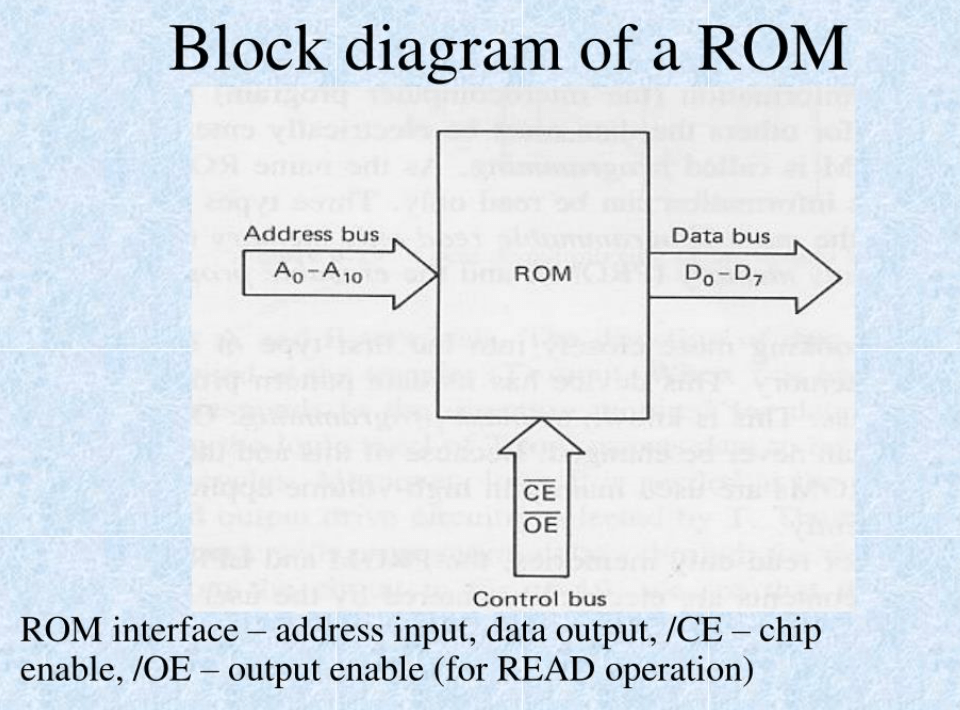
Figure 8: Block Diagram of ROM
Detailed Block Diagram Analysis of Read-Only Memory
A ROM chip is built with a precise arrangement of input and output lines within an integrated circuit, featuring required components like decoders and OR gates. This structured design defines how data is accessed and processed within the chip. ROM contains a matrix of input lines (address lines) and output lines (data lines) that store and retrieve various data combinations.
Each data point in ROM is accessed via binary address inputs that activate the decoders. These decoders interpret the addresses to select the specific data word needed. The chosen data word is then sent through the output lines, facilitated by OR gates that combine multiple input signals into a single output. This method ensures precise data retrieval, matching the current operational demands of the device, and enabling the immediate and correct execution of stored instructions.
ROM’s organized and fixed structure delivers high-speed data access and reliable data retrieval. This is influential for the foundational tasks ROM chips perform in various electronic devices, ensuring consistent and dependable performance.
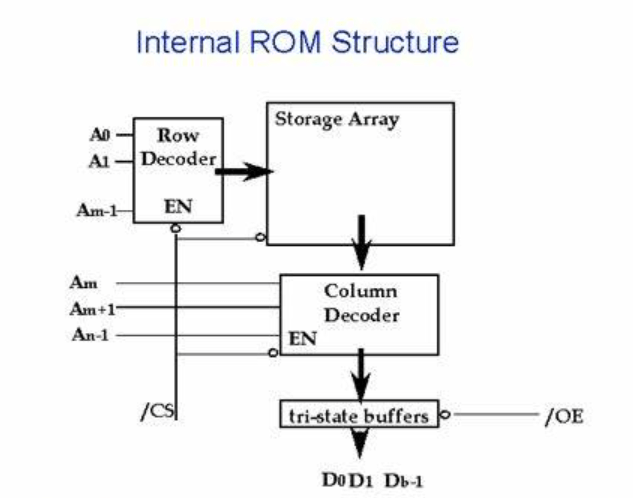
Figure 9: Internal Structure of ROM
Exploring the Internal Architecture of ROM
The internal architecture of a ROM, such as a 64 x 4 ROM, showcases its efficient data storage capabilities. This ROM configuration includes 64 words, each containing 4 bits. This structure allows various data combinations to be stored, each accessible through specific input addresses.
Each input address corresponds directly to one of the 64 words. When an address is inputted, the ROM's internal circuitry, which includes address decoders and data lines, selects and outputs the corresponding 4-bit data word. This retrieval process is rapid and accurate, ensuring data is delivered exactly as stored.
This definitive design highlights how ROM supports the stability and reliability of electronic systems. It provides a consistent and unchangeable foundation that electronic devices rely on for performing basic operations efficiently and error-free. This architecture is settling not only for the functioning of the ROM itself but also for the overall reliability of the systems it supports.
Characteristics of Read-Only Memory
Non-Volatility
ROM's non-volatile nature ensures that data remains intact even when the power is off. This makes it ideal for storing unsafe firmware and system settings that must be reliably available when the device starts up.
Data Permanence
Once data is written to ROM during manufacturing, it cannot be changed. This permanence protects the data from unintended modifications, ensuring consistency and reliability. This feature is influential in applications where operational stability is a must, such as in medical devices, industrial control systems, and foundational computing components.
Read-Only Format
The read-only format of the ROM prevents data from being accidentally altered. This helps maintain system integrity and reliability in the event of a security breach.
Figure 10: RAM & ROM
Comparing ROM and RAM
• Purpose and Function: ROM (Read-Only Memory) and RAM (Random Access Memory) serve distinct roles in computing systems. ROM is for long-term storage of key system data, such as firmware and system instructions. This data is permanently written and remains intact regardless of the power state, providing needed stability from startup.
• Volatility and Data Retention: In contrast, RAM is for temporary data storage, facilitating the active processing of applications and tasks. RAM is volatile, meaning data is lost when the device is powered off. However, it allows for rapid read and write operations, making it ideal for handling the dynamic requirements of operating systems and applications.
• Complementary Roles: Together, ROM and RAM form a serious infrastructure in computing devices. ROM ensures reliable, unchangeable access to ultimate system instructions, while RAM supports the execution of current tasks with flexibility and speed. This highlights their requisite but distinctly different roles in the computing ecosystem.
Benefits of Using Read-Only Memory
|
Benefits of Using Read-Only Memory |
|
|
Secure Storage of Needed Instructions |
ROM securely stores analytic system
instructions, such as firmware and boot settings. These instructions are
dynamic for both the initial startup and ongoing operation of devices. |
|
Non-Volatile Reliability |
ROM's non-volatile nature ensures that
stored data remains intact without power. This means devices can operate
correctly immediately upon startup, without needing to reload data or risk
data loss. This reliability is especially settling for devices in
environments requiring consistent operation, such as medical equipment or
industrial control systems. |
|
Cost-Effectiveness |
Compared to RAM, ROM is generally cheaper
to produce and requires less power, making it an economical choice for
storing permanent data. Its cost efficiency, durability, and stability make
ROM requisite in various electronic devices, ensuring they have reliable
access to required data and instructions at all times. |
Limitations and Challenges of ROM
Difficulty in Updating Data
One primary limitation of ROM is its inability to update stored data easily. Once programmed, modifying ROM requires complex and costly processes, making it unsuitable for applications needing regular updates or changes.
Lower Storage Capacity
ROM generally has a lower storage capacity compared to other memory types like dynamic RAM or flash memory. This limitation restricts the amount of data or complexity of programs that can be stored, affecting its use in advanced computing systems.
Slower Data Access Speeds
ROM tends to have slower data access speeds than other memory types, which can hinder system performance, especially in scenarios requiring rapid data retrieval.
Technological Obsolescence
Older types of ROM, such as Mask ROM, are becoming obsolete as more flexible and update-friendly technologies emerge. The higher production costs associated with some forms of ROM add to this challenge.
Need for Continuous Innovation
To remain effective and relevant, particularly in applications where stability and reliability are insistent, ROM technology must continually evolve. Advancements are compulsory to address these limitations and ensure ROM can meet the demands of modern technological environments.
Conclusion
ROM's architecture and functional capabilities primarily underpin the operational integrity and reliability of electronic devices. Despite its limitations in storage capacity and update flexibility, ROM remains a cornerstone of digital technology due to its non-volatile nature and secure data storage. This article has comprehensively examined the various aspects of ROM, from its structural and operational nuances to its categorical types and their specific applications. It also censoriously assessed the challenges facing ROM technology, such as the need for continual innovation and adaptation to overcome obsolescence and meet modern demands. As the digital landscape evolves, the role of ROM is likely to be shaped by advancements that enhance its functionality and application, ensuring that it continues to provide a stable and reliable foundation for the computing needs of tomorrow. The enduring relevance of ROM in the computing ecosystem is a testament to its foundational importance, securing its place as a needed component of modern technology.
Frequently Asked Questions [FAQ]
1. What characteristics makes read-only memory ROM useful?
Read-only memory (ROM) is useful for storing permanent or semi-permanent data that should not change during device operation. Its non-volatile nature means it retains data without power, making it ideal for storing firmware or system software that boots up electronic devices like computers, smartphones, and other appliances.
2. Why use read-only?
ROM is used primarily because it provides secure and stable storage for required data that must remain unchanged. This includes serious system instructions that hardware needs upon startup. Since ROM cannot be easily modified, it protects the data from accidental changes or software issues that could disrupt the device's ultimate operations.
3. What are the three types of ROM answers?
Masked ROM (MROM): Programmed during the manufacturing process and cannot be reprogrammed.
Programmable ROM (PROM): Can be programmed once after manufacturing; once programmed, the data cannot be changed.
Erasable Programmable ROM (EPROM): Can be erased and reprogrammed using ultraviolet light.
Electrically Erasable Programmable ROM (EEPROM): This can be erased and reprogrammed electrically, often byte by byte, making it more flexible.
4. What is the function of ROM?
ROM's primary function is to store the initial software that runs when a device is turned on. This software, known as the firmware, includes the basic instructions for starting the device and performing basic hardware checks before loading the operating system. It ensures consistent, reliable operation by providing a dependable set of instructions that the device can follow every time it is powered on.
5. What is an example of ROM?
A common example of ROM is the BIOS (Basic Input/Output System) in computers. The BIOS is firmware stored in ROM, responsible for initializing and testing hardware components like the keyboard, mouse, and disk drives at startup before handing control over to the operating system.